Why is My Cell Service So Bad?
Why Cell Signal Goes Bad and Calls Keep Dropping
Suddenly no cell service at home or in the office? You're not alone.
Poor cell phone signal is a common issue. According to a PEW survey, 72% of American cell phone owners experience dropped calls and 77% experience slow download speeds. Other reports state cellular signal challenges have increased since early 2021.
But why does cell service go bad? Keep reading to discover the top 10 things that hurt your cellular reception.
We fix poor cell phone signal! Find the right signal booster for you:



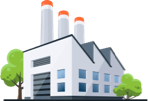
What Causes Bad Cell Phone Signal?
If your cell service goes from decent to unstable, there is always a reason. Let’s go through the most common.
1) Building Materials

Building materials in your house, workplace, or run-of-the-mill shopping mall are the main culprits for weaker cell signal in America. Cellular signals have a hard time penetrating metal, tinted low-E glass, concrete, and many other materials, which could be why your signal is so bad.
Notably, the impact is more pronounced on 5G compared to 4G. The higher frequencies used by 5G make it more susceptible to disturbance.
So, if you routinely experience fading cell service indoors, it's likely that construction materials are hindering your connection. Here is a list of building materials that block cell phone signals and by how much:
| Building Material | dB Loss |
| Foliage | -3 to -20 |
| Drywall | -2 |
| Fiberglass Insulation | -2 |
| Clear Glass | -4 |
| Plywood | -4 to -6 |
| Solid wood | -5 to -12 |
| Plaster | -8 to -16 |
| Brick & Stone | -8 to -28 |
| Concrete & Cement (6 inches) | -10 to -20 |
| Tinted & Low-E Glass | -24 to -40 |
| Metal | -32 to -50 |
*dB represents gain or loss of cellular signal strength. Every -3 dB (loss) halves the power.
TIP: While not the most convenient solution, try using your phone near an open window or step outside. A better option is a cell phone signal booster. It can help bypass signal-blocking materials and deliver a stronger signal wherever you need it. We will talk more about them shortly.
Related Blog: Building Materials that Kill Your Cell Phone Reception
2) Cell Tower Distance

Cellular signals can only travel so far. It’s unclear as to how far exactly. Some sources state up to 25 miles while others say 45 miles. Actual distance is influenced by factors such as:
- Frequencies - Lower frequencies, like those utilized by 4G and low-band 5G, can cover greater distances. In contrast, higher frequencies, such as those employed by C-Band and mmWave, have a shorter range.
- Transmission Power - To avoid interference, not all cell towers transmit cellular signals at the same power level. Some are designed to cover more ground than others.
- Surrounding Terrain - Any obstacles like buildings, trees, hills, etc. can significantly reduce the range of cellular signals.
The further you are from a cell tower, and the more obstacles in the way, the weaker the signal gets. This leads to the "fish tank" voice, constant say-and-repeat moments, and the dreaded one-bar service. People living or traveling in rural areas tend to be the main victims.
TIP: Since relocating closer to your carrier's cell tower is impractical, consider a cellular signal booster. They use a powerful amplifier and antennas to communicate with distant cell towers and deliver a stronger signal where you need it. Alternatively, you can switch to the carrier that offers the best coverage in your area.
Related Blog: How to Find Your Nearest Cell Tower
3) Congested Mobile Network

Cell phones communicate with cell sites to send and receive calls, texts, and data. Cell towers and small cells can only handle so many devices at a time.
In heavily populated areas, all devices are fighting for a spot on the nearest cell tower. As more people connect, the signal becomes weaker for everybody, resulting in dropped calls and buffering videos. This can happen while stuck in traffic, at a festival, or at home during peak hours.
Due to limited capacity, cellular providers have network management policies in place. They throttle your connection during times of congestion after exceeding a certain number of GBs specified on your plan. The more expensive your plan, the more priority you’re given over the cellular network. They also prioritize devices with a stronger connection to the tower
TIP: To mitigate cell signal challenges due to heavy cellular traffic, consider upgrading your wireless plan. You can also use a signal booster to strengthen the signal transmitted between your cell tower and device. This will allow you to keep your connection strong even during times of congestion.
4) Bad Coverage and Dead Zones

There are many pockets around the nation that aren’t covered by specific service providers. If you suddenly lose cell service, you may be in a dead zone.
Dead zones are areas without cellular reception. They occur whenever there is any kind of obstruction between the user and the cell phone tower or a lack of towers in general.
You can use your carrier's coverage map to find out if you’re within coverage range.
| AT&T Coverage Map | T-Mobile Coverage Map | Verizon Coverage Map |
However, coverage maps are purely estimates. They are not 100% accurate. DeadCellZones.com is also a great resource. All data is crowdsourced.
TIP: The best way to get service in an area without signal is using WiFi calling or investing in a Femtocell. Broadband internet is required for both. Occasionally, though, a faint signal is present but too weak for your phone to register. In those cases, a signal booster can help.
Related Blog: How to Get Cell Phone Signal in a Dead Zone?
5) Landscape

Geographic features often cause signal to go bad. Trees, for example, are notorious for blocking cell phone signals. Whether you’re hiking or your house is surrounded by large foliage, the leaf canopy can cause a massive drop in cellular reception.
Mountains, hills, and valleys, too. Just like building materials, cellular signals have a hard time penetrating natural barriers. If you live on one side of a mountain, and the only cell tower in your area is on the other, you’re not likely to get good reception.
TIP: Unless you’re able to cut down the trees or change location, a signal booster is your best bet against natural barriers.
6) Weather

Shockingly, weather can affect cell service. Cell phones transmit and receive electromagnetic waves. Weather phenomena, such as humidity, thunder, lightning, wind, rain, snow, and ice, disrupt the waves, degrading performance.
TIP: Unfortunately, there’s not much you can do about weather, it’s out of anybody’s control. Though, a signal booster can help fine-tune the signal received from your nearest cell tower. Even during bad weather, you'll be able to enjoy reliable talk, text, and data speeds.
Related Blog: How Does Weather Affect Cell Phone Signal?
7) Phones Age
Using an outdated iPhone or Android phone could contribute to sudden bad reception. As carriers add new frequencies to their network and sunset others, compatibility issues arise. Unable to tap into those newer frequencies, your phone may struggle to maintain a reliable connection.
TIP: Upgrade your device.
8) Blocking Your Antenna
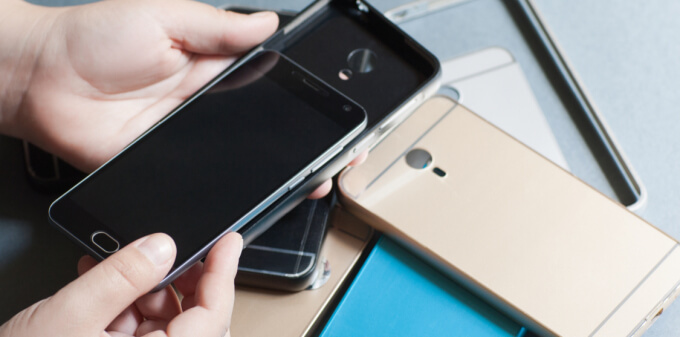
All mobile phones use antennas to transmit cellular signals. Back in the day, phones had extractable exterior antennas. Sure, they were big, heavy, and unwieldy, but their signal was pretty consistent. That’s partly due to their impossible-to-block exterior antennas.
Today’s phones have antennas embedded inside. Anything blocking the antenna, whether it’s your hand, a magnetic plate, or a metal case, can hurt reception. Where exactly the internal antenna is depends on your phone model. A quick Google search can help you identify its location.
A decrease in signal strength due to blocking the antenna may not be noticeable in areas with strong reception. However, it can make a huge difference in near-dead zone environments.
TIP: Find the location of your antenna and avoid blocking it with your hand or a magnetic phone mount plate. Try not to use thick or metal cases that can hinder the amount of signal the antenna receives.
9) Low Battery
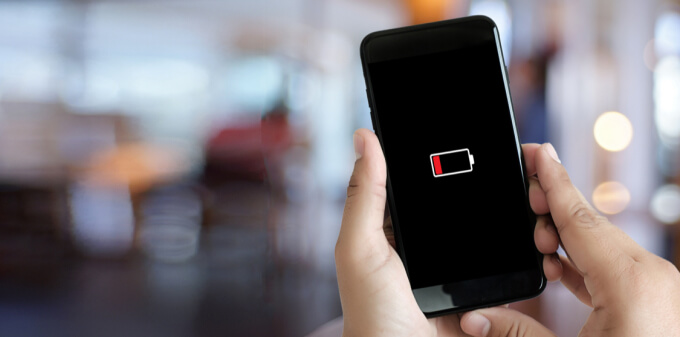
Cellular phones need energy to maintain a connection with a cell tower. They may struggle sending and receiving a strong signal when the battery is low.
TIP: Don’t put off charging your phone. You may find yourself with a weak signal when you need it most. If you don’t have access to a power source, try to have a charged power bank on hand at all times just in case.
Related Blog: Tips for Better Cell Phone Battery Life
10) Cosmic Events: Solar Flares

Eruptions on the surface of the sun send plumes of gas into the atmosphere and have been known to disrupt mobile phone communications. These so-called solar flares produce shock waves that travel through space. They can disrupt the signals sent to and from a satellite and produce changes in the Earth’s magnetic field. Obviously, this does not bode well for your cellular signal.
TIP: Unfortunately, there is not much that can be done about cosmic events.
FAQs About Cell Signal Suddenly Going Bad
Can a Cell Phone Case Affect Signal?
Yes. Some phone cases can prevent signal from reaching your phone’s internal antenna.
Thin leather, plastic, or rubber cases won’t significantly affect your cell signal. HOWEVER, metal cases, thick battery cases, and the like pose a greater threat to your connection.
Do Magnets Affect Signal?
Electromagnetic fields can cause signal interference, yes.
However, ordinary magnets, such as ones you might find in a bracelet clasp, headphone speaker, or electric motors, will not. There are actually magnets in your cell phones themselves.
Does Weak Signal Drain My Battery?
Definitely. Your phone has to work significantly harder to communicate to and from your cell tower with weaker signal. This results in significantly shorter battery life.
Can an Old Phone Cause Bad Service?
Yes. As cellular technology evolves, so do phones.
Older phones don’t have the technology needed to tap into the best and fastest networks available. While your friends are enjoying crisp calls or ultra-fast data, you may be stuck on an unreliable network. As time goes on, older phones also lose software update capabilities, which help with performance.
Does Smoke Affect Cell Phone Signal?
It can. Smoke can reflect and absorb cellular signals, degrading performance. Higher frequencies are affected more than lower frequencies. By how much depends on the density of the smoke.
How to Fix Bad Cell Signal?
There are a variety of simple fixes you can try to improve your signal. Visit our Easy Ways to Boost Cell Signal blog for a complete list.
However, cell phone signal boosters are the best and most reliable way to boost cell signals at home, in the office, or on the go.
A cellular booster pulls in existing 5G/4G/LTE signals, amplifies them, and rebroadcasts the boosted signal where you need it. This is done using:
- Cellular Antennas – Outdoor antenna pulls in weak signal and indoor antenna broadcasts boosted signal.
- An Amplifier – Boosts cell signals up to 32 times.
- Coaxial Cables – Connects everything together and helps bypass building material.
The results? Dropped phone calls, failed texts, and slow data speeds will be a thing of the past.
They are compatible with all cellular devices and carriers. They do not need WiFi or a broadband connection to work. And you don’t have to worry about paying a monthly fee – it's a one-time purchase. For more information on how signal boosters work, click here.
Below are our top signal repeater models for increasing your phone’s signal and service at home, office, or vehicle.
Signal Boosters for Home
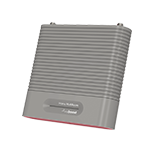
For midsize homes with strong outside signal or small homes with poor outside signal.
Add To Cart- Amplifies 5G, 4G, and LTE Signals
- Up to 5,000 Sq Ft Coverage
- Up to 65 dB Gain
- Up to 21 dBm Uplink and 12 dBm Downlink
- Includes Outdoor Yagi Antenna and Stylish Indoor Panel Antenna
The weBoost Home MultiRoom does a phenomenal job at bypassing most of the reasons cell phone signals go bad, without denting your pocket. That’s why it’s our most popular unit.
Using a powerful directional antenna, it can reach faraway cell towers and fine-tune the received cell signals. It offers up to 5,000 sq ft of coverage. That’s enough to improve cell phone service in multiple rooms, an entire floor, or a whole midsize, one-story home. Coverage will vary depending on your existing outside signal strength.
If you’re in an area with next to no signal, this is the lowest-grade home signal amplifier you should ever consider buying.
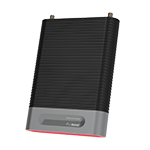
For large homes with a strong outside signal or midsize homes with poor outside signal.
Add To Cart- Amplifies 5G, 4G, and LTE Signals
- Up to 7,500 Sq Ft Coverage
- Up to +72 dB of gain, with 24 dBm uplink and 12 dBm downlink
- Up to 72 dB Gain
- Up to 24 dBm Uplink and 12 dBm Downlink
- Includes Outdoor Yagi Antenna and Stylish Indoor Panel Antenna
The weBoost Home Complete is the most powerful consumer line booster you can get. With an additional +5 dB over the Home MultiRoom, it's roughly a shade over 3x more powerful. Featuring higher uplink, it can also reach cell towers located even further than the Home MultiRoom. For those in extremely fringe areas, this unit is perfect.
Under optimal conditions, it can cover up to 7,500 sq ft with enhanced cell reception. To maximize coverage, the booster can be paired with additional indoor antennas (sold separately).
The Home Complete is a self-install unit. If you prefer a professional installation, consider the weBoost Home Complete Installed.
Signal Boosters for Vehicles
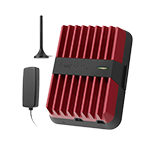
- Boosts 5G/4G/LTE
- Up to 50 dB Gain – Max Allowed for Mobile Boosters
- Up to 26.9 dBm Uplink and 4.8 dBm Downlink
- Sleek, Metallic Design to Displace Excess Heat for Peak Performance
- Extremely Customizable to Fit Any Type of Vehicle and Setup
The weBoost Drive Reach is the most powerful vehicle booster from Wilson Electronic. It features the maximum gain allowed for mobile boosters and the highest uplink power of any vehicle booster. It can easily bypass signal-blocking material and consistently connect to towers 2x further while on the go.
Under optimal conditions, it can deliver stronger 5G/4G/LTE signals throughout most of your vehicle's cabin. There is a Drive Reach for any vehicle type – cars, pickup trucks, SUVs, boats, RVs, and semis.
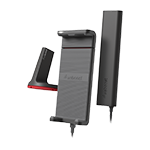
- Boosts 5G/4G/LTE
- Up to 23 dB Gain
- Up to 25.5 dBm Uplink and 2.5 dBm Downlink
- Cradle Mount Unit
- For a Single Smartphone
The weBoost Drive Sleek is about price and performance for a single device.
The kit includes an easy-to-install magnet mount antenna and an adjustable cradle vent mount designed to hold any size phone. To benefit from the boosted signal, your cellular device has to sit in the cradle. Delivering a stronger signal directly to your device ensures reliable talk, text, and data while driving through trouble zones. And when paired with a Bluetooth headset, it really shines for hands-free calling and navigation.
It works best in urban and suburban areas but is not the strongest performer in extremely remote locations. For those extreme cases of poor cellular reception on the road, consider upgrading to the Drive Reach.
Signal Boosters for Small Businesses

- Boosts Talk, Text, and 5G/4G/LTE Data
- Up to 25,000 Sq Ft Coverage
- Up to 72 dB Gain
- Up to 25.8 dBm Uplink and 13.6 dBm Downlink
- Extremely Customizable to Fit Any Type Building Layout
Whether your business is suffering due to cell tower distance, rugged terrain, or tough building material, the Office 100 can help. It’s our best-selling commercial-grade amplifier for small businesses anywhere. It’s also a great option for large homes in remote areas where a residential booster may not be powerful enough to deliver desired results.
Featuring high gain and output powers, it can reach distant cell towers and cover up to 8,000 sq ft. No more dropped calls, undelivered texts, or slow data. Communication and productivity are sure to improve, keeping your business running smoothly. There are multiple variants available to fit different building layouts and signal environments.
For more power and coverage, consider the weBoost Office 200. To see how the Office 100 and 200 compare, click here.
Wilson Amplifiers Can Help You Fix Bad Cell Phone Reception
Wilson Amplifiers is the leading provider of cellular amplifiers for homes, offices, and vehicles. All of our units boost 5G, 4G, and LTE for any phone with any carrier.
We seriously hate dropped calls and poor coverage. It's our goal to stomp out spotty signal and ensure you stay connected whenever you need it. Whatever is causing your signal to go bad, a signal booster can help relatively everywhere.
Call us (1-800-568-2723), email (sales@wilsonamplifiers.com), or chat with us, for a free consultation. Ask us anything, we’re happy to help!
Interested in Learning More? Check Out Our Signal Boosting Info Center


Money Back Guarantee

Technical Support